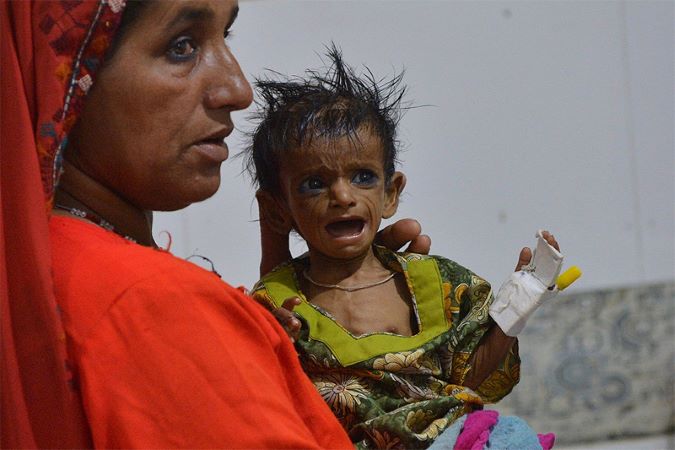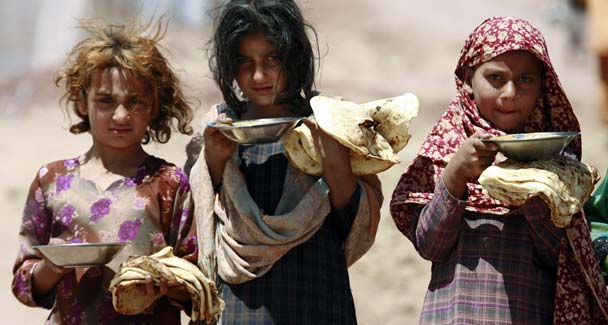
Some parents in Dadu and Tando Muhammad Khan districts treated their malnourished children through local practices under cultural beliefs
Aajiz Hussain Siyal
Following the 2022 flood, a substantial population was displaced, losing their livelihoods and seeking refuge in relief camps situated across different cities in Sindh. These camps, established by both NGOs and government entities, aimed to provide shelter. The flood’s impact was particularly harsh on residents in Sindh, with malnourished children suffering the most. Malnutrition, a global issue affecting many countries, also heavily affects Pakistan, where millions, both children and adults, struggle with it. Disturbingly, nearly 10 million Pakistani children suffer from stunting, as reported by UNICEF.
The flood of 2022 exacerbated existing challenges for affected families. Among these, children bore the brunt of malnutrition, especially those living in relief camps due to their families’ dire economic conditions. In addition, the flood’s destruction of economic resources further strained children’s diets, particularly in Sindh. Cattle, a vital source of milk for many children, perished in the flood, aggravating the situation.
One family applied local remedies to a weak baby by birth that included covering the child’s body with cotton except for the nose, and using burning coils to keep the baby warm
Malnourished children, already at risk before the flood, faced heightened vulnerability. They were susceptible to various diseases, impeding both their physical and cognitive development, while also increasing mortality rates. The dire consequences of the flood and subsequent rains worsened the plight of the already malnourished children. Most families residing in relief camps belonged to low-income groups, resulting in inadequate nutrient intake and heightened susceptibility to malnutrition.
Transitioning to camps led to an exacerbation of children’s malnutrition due to reduced nutrition availability. Consequently, various diseases emerged, including diarrhea, vomiting, edema, chest congestion, low cognitive growth, acute bronchitis, malaria, and cough. Tragically, lack of financial means prevented parents from accessing necessary medical care. In rural Sindh, insufficient health facilities further exacerbated this issue, as government hospitals faced shortages of medicine and inadequate treatment capacity.
Read related article: Almost half the population of Sindh suffers from malnutrition
One significant factor that has played a key role in the alarming increase of malnourished populations is the lack of effective family planning. This issue becomes particularly pronounced when young, malnourished mothers continue to give birth year after year without adequate spacing. These mothers, already struggling with their own nutritional deficiencies, find themselves in a challenging predicament, having to bear the physical toll of frequent childbirth. Consequently, the infants born into such circumstances are deprived of the nourishing breast milk that they desperately need for healthy development.

Malnutrition affects individuals of all ages, but it predominantly impacts women and girls due to factors such as food scarcity, insufficient dietary intake, and increased workload with limited access to nourishment, which significantly jeopardizes their health. Most of the women I interviewed during field work in Dadu and Tando Muhammad Khan districts were primarily homemakers, responsible for household chores, child-rearing, and even tending to animals.
Many of these women took on these responsibilities both before and after marriage. Living in a rural setting, they lacked awareness about proper nutrition and had limited access to educational resources. Illiteracy was common among both men and women I encountered during my fieldwork. Moreover, they expressed their ignorance regarding the importance of a balanced diet for their children. They lamented that government and NGO efforts had not reached their village, leaving them uninformed about children’s nutritional needs and dietary choices.
These villagers were unaware of modern nutritional trends, relying solely on traditional knowledge passed down from their elders. Despite their dire circumstances, they voiced frustration with the entrenched feudal system, which often led NGO representatives and government aid workers to bypass them in favor of landlords. As one respondent put it, “We are poor people, so no one reaches out to us.”
The community shared tales of unconventional treatments like “Kumi Te Winhjaranr,” involving bathing a child on a turtle
Furthermore, the burden on these frail mothers is exacerbated as they attempt to nourish multiple children concurrently, often without receiving sufficient nutrition themselves. This vicious cycle perpetuates the problem, with malnourished mothers unable to provide their offspring with the essential sustenance required for proper growth and development. Addressing this issue is not only crucial for the well-being of individual families but also for combating the broader challenge of malnutrition in our society.
The absence of proper medical care led many to rely on cultural and local remedies. Some parents treated their malnourished children through local practices. Examples included the “Sonr” treatment for stomach issues, “Nazar Jo Dhago Patrayo” amulets for protection from the evil eye, and “Bili Te Winhjaranr,” where a cat was placed beneath a cot during a child’s bath. The community shared tales of unconventional treatments, like “Kumi Te Winjharanr,” involving bathing a child on a turtle. One family recounted their child’s weakness at birth, where they employed local remedies, including covering the child’s body with cotton except for the nose, and using burning coils to keep the baby warm. Awareness about malnutrition remains lacking among many who mistake it for a disease. Consequently, there’s a need to educate people about this critical issue.
Also read: Pakistan still an ‘ongoing nightmare’ for millions of children, following major flooding
________________
Aajiz Hussain Siyal is a Medical Anthropologist. He did his BS Anthropology in December-2022 from University of Sindh. He is a field-based researcher and is currently working in the field of medical anthropology with a focus on public health and child health issues in particular. He has also worked with UNO and multiple voluntary teams during COVID-19. His areas of interest are, Anthropology, Folk Medicine, Healthcare, Culture and Social Change. He can be accessed at email: aajiz.anthro@gmail.com